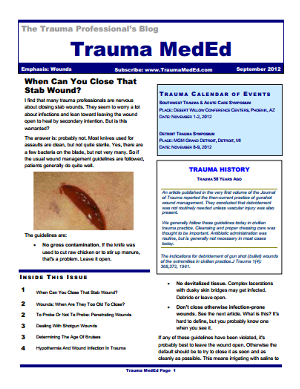Patients with chest trauma sustain hemothorax on occasion. The trauma professional usually picks this diagnosis up in the initial evaluation and makes a decision whether or not to drain it. The parameters for this decision are not very clear, even today. But what happens when there is residual hemothorax? Should we be more aggressive in getting it out?
All this boils down to an understanding of the natural history of retained hemothorax. This kind of information can help us decide whether to be more aggressive in our efforts to remove it. The results of a multicenter study looking at this issue was published recently. They focused on patients who had a chest tube placed for management of either hemo- or pneumothorax within 24 hours of admission. Patients who had suspected retained hemothorax after tube removal received a CT scan within 14 days. The usual outcomes were studied (length of stay, complications) as well as development of empyema (purulence, acidic pleural fluid, positive Gram stain or culture).
Some interesting results:
- 328 patients were enrolled across 20 centers. Not a lot, but one of the bigger studies to date.
- Empyema was diagnosed in 27% of patients
- Risk factors identified included rib fractures, ISS > 25, and performance of additional interventions for drainage
- Patients who developed empyema stayed in the ICU and the hospital longer
Bottom line: Retained hemothorax turns into a very serious problem in a quarter of trauma patients who have a chest tube inserted. The presence of residual blood after the chest tube is removed should prompt us to figure out if it’s solid clot or liquid blood (remember the old decubitus view chest xray? They still work!). If it’s liquid, consider drainage via thoracentesis or a smaller catheter. If it’s clot, it may require more invasive techniques to drain it (VATS). If you decide to send the patient home, have them watch out for fevers, chest pain, dyspnea and other symptoms and signs of a developing complication, and make sure they report it to you promptly.
Related post:
Reference: Development of posttraumatic empyema in patients with retained hemothorax: Results of a prospective, observational AAST study. J Trauma 73(3):752-757, 2012.


